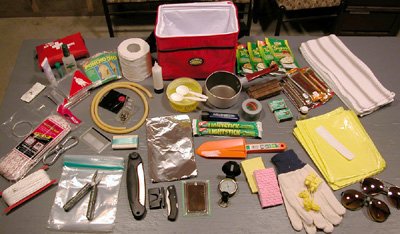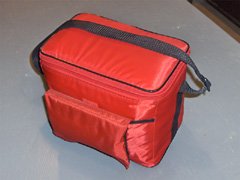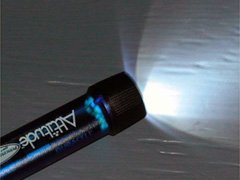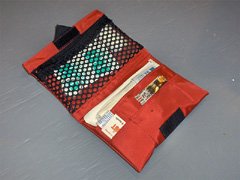Emergency Survival Kit
August 3, 2006
In September of 2003, I set out on my first cross country flight over an uninhabited area, the wilderness of Northern Ontario. Until then, I’ve never been required (or felt the need) to carry any sort of survival kit other than the first aid kit already in the plane. I looked at the various aviation survival kits commercially available and found they were all either too expensive, too incomplete, or both.
Being a do-it-yourself sort of person, I decided to assemble my own, so I did some research. The best source of information I found was Doug Ritter’s Equipped to Survive™ site. From there I got an understanding of what would and would not be useful and started assembling a shopping list. Even if you don’t want to build your own kit, I recommend reading the reviews of available kits so you can buy an adequate one.
Here’s what I ended up with in my homemade kit:

The entire contents of my survival kit except the manual, manifest, and grease pencil. Click for a closer look.
Everything you see fits in the red water resistant soft-sided cooler you see at the top center of the picture. It will even float for quite a while. Here is a list of everything in the kit, along with a few survival items that I always keep in my flight bag:
| Survival Kit Contents | |
|---|---|
Communications/Signalling
Emergency Devices
Protection/Shelter
|
Medical Supplies
Food and Water
Miscellaneous
|
|
Items in italics are perishable or have perishable contents. Check annually.
|
|
The contents are divided into six categories that reflect the primary use of each item, although some items can be used for multiple purposes. For instance, the “head towels” are just dish towels, which can be used for head protection, bandaging, or as towels. Most of the items are self-explanatory, but I’d like to elaborate on a few of them.
Radio
My handheld radio is an ICOM A4. I purchased the model with the rechargeable NiMH battery since that’s all the local supplier had. This is less than ideal unless you remember to make sure it’s charged before every flight. Rechargeable batteries tend to self-discharge rather quickly (about 1% per day), which alkalines don’t do. In the mean time, I make a point of charging the radio before heading out on any cross-country flights.
Flashlight
The flashlight is a waterproof PrincetonTec® Attitude™ light with three ultra-bright white LEDs, powered by 4 AAA alkaline cells. I use name-brand batteries with expiry dates, and ensure that I replace them before their shelf-life is up. I also keep an extra set in the survival kit. I should also probably keep a spare set of AA cells in the kit for the GPS.
This is a great flashlight, but one annoyance about it is that some of the light spills out of the back of the LED module and through the translucent case. I found this to be bright enough to spoil my night vision. I solved this problem by simply painting the back and sides of the LED module with silver paint as shown in the photo.

Painting the outside of the LED module with silver paint keeps the light shining in the right direction.
Survival Manual
A survival kit is of little use if you don’t know how to use its contents. I read many reviews of survival manuals, but eventually decided I’d make my own, sort of. I started with the freely available SURVIVAL, EVASION, AND RECOVERY – Multiservice Procedures for Survival, Evasion, and Recovery produced for the United States Army, Marine Corps, Navy, and Air Force. Rather than just printing the manual as-is, I did some editing:
- I removed all the sections that were combat specific, such as evasion and dealing with various forms of attack.
- I redid the text in many of the images, since much of it was almost illegible.
I then printed the manual in a form suitable for top binding, put a pair of covers on it, and slipped it into the pocket inside the top of the cooler. This pocket also holds a laminated copy of the equipment manifest, and a grease pencil that can write on almost anything (rocks, trees, airplanes, etc.).
All that editing had the additional advantage of forcing me to read the material over and over. If I ever do need to use it, I’ll have the advantage of already being somewhat familiar with it.
I’ve produced a PDF version of my revised version of the survival manual (3Mb file size). It’s designed to be printed double-sided, after which about 1½ inches should be trimmed off all four edges of the pages before binding. Leave a bit extra on the edge you want to bind.
First Aid Kit
Rather than incorporating all the components of a first aid kit into the survival kit, I just purchased a small camping first aid kit in a folding pouch. The pouch is normally held closed by Velcro®. I inserted one half of the pouch into the pocket on the front of the cooler, and then glued a piece of Velcro on the cooler for the other half of the pouch to stick to. This way, the first aid kit doesn’t take up any space inside the survival kit, and can be accessed without digging it out from under everything else.
Other Preparations
In addition to the survival kit, it’s important to bring clothes suitable for the conditions that might be encountered. In spring, summer, or fall, I usually bring a light-weight but warm Coleman® rain jacket. In winter I’ll bring a parka and winter boots.
The best survival aid is to file a flight plan, and then stick to it. That way, if you go missing and are unable to call for help, it won’t be long before your absence is noticed, and the rescue team will have a really good idea of where to find you. If you must deviate from your flight plan, or if you end up behind or ahead of schedule, contact a flight service station and let them know. In fact, it’s generally a good idea to provide position reports from time to time.
With good planning and a tiny bit of luck, you’ll never have to open your survival kit except to replenish the perishable supplies. But if you do find yourself down in the wilderness, don’t panic, because you’re prepared.
Related Articles
If you've found this article useful, you may also be interested in:
- A Tale of Two Whiz Wheels: E6-B versus CR Wind Solutions
- Checklists for the Cessna 172N/152 and Diamond DA20-A1
- Aviator Sunglasses

If you've found this article useful, consider leaving a donation in Stefan's memory to help support stefanv.com
Disclaimer: Although every effort has been made to ensure accuracy and reliability, the information on this web page is presented without warranty of any kind, and Stefan Vorkoetter assumes no liability for direct or consequential damages caused by its use. It is up to you, the reader, to determine the suitability of, and assume responsibility for, the use of this information. Links to Amazon.com merchandise are provided in association with Amazon.com. Links to eBay searches are provided in association with the eBay partner network.
Copyright: All materials on this web site, including the text, images, and mark-up, are Copyright © 2025 by Stefan Vorkoetter unless otherwise noted. All rights reserved. Unauthorized duplication prohibited. You may link to this site or pages within it, but you may not link directly to images on this site, and you may not copy any material from this site to another web site or other publication without express written permission. You may make copies for your own personal use.



Richard Rakoff
November 28, 2007
You left out survival weapons by design or what?
Stefan Vorkoetter
November 29, 2007
What weapons? It’s a survival kit, not a survivalist kit. I’ve never seen a commercial aviation survival kit with any weapons in it other than a pocket knife.
Don Rearic
May 24, 2009
"Survival" versus "Survivalist" Kit is a non-starter argument/debate for me. Just my opinion. If you are into "survival," i.e., continuing to suck air to live, you’re a "survivalist" and you’re into "survivalism."
I have no idea about Canadian Laws so I cannot speak for them, but a lot of Bush Pilots in Alaska carry large caliber handguns or .444 Marlin or .45-70 Govt. lever action take down rifles as "survival tools" especially for bear defense. The other fellow that left a comment was not being rude, just asking a legitimate question.
Stefan Vorkoetter
May 24, 2009
Don, you’re probably right that Richard just meant it as an innocent question, and for flying in Alaska or the Canadian north, a rifle is probably a good thing to have. Where I fly, a rifle isn’t going to do a lot of good.
I beg to differ on equating with "survival" with "survivalist" though. To me, a survivalist is someone making preparations for end-of-civilization survival, not for living long enough after a plane wreck to get rescued.
Christian
March 09, 2010
Dude! Get a led-headlight instead of a normal flashlight. They can be had for cheap but are a LIFESAVER when you are out and about! Easily one of the top outdoor innovations of the last … decade? 😉
I do camp a lot outside and they have become indispensable for me, especially considering you will be all by yourself and might have to deal with maps or complicated repairs – you don’t wanna have one hand occupied holding a flashlight all the time!
All the best from Berlin Germany
Christian
Jeffrey Solomon
March 21, 2011
wants to walk for a few months in the northern wilderness
oscar
March 31, 2011
It’s time to get up and prepare a set of survival kit. You can never tell when the time communication, power and other thngs shuts down. When the depopulation starts, we have to be prepared to try to survive.
Ben Hasselbach
October 17, 2011
you should have a way to make a fire like mathches or a lighter
Stefan Vorkoetter
October 19, 2011
Ben, do you mean like the 2 boxes of waterproof matches and 5 fire sticks that are already in there (and on the list)?
James
June 22, 2012
Great survival manual. Thank you.
Mi5kem
July 13, 2012
You might consider adding a “Sam Splint” to the first aid kit if it does not have one…lightweight, and can be bent to conform and stabilize many fracture injuries…cheap, and easy to use.
glassman2004
May 27, 2017
Another useful item is a tube of superglue. This stuff is useful for all kinds of repair but especially for use as an emergency suture – it is what it was invented for.
Stefan Vorkoetter
May 27, 2017
Good idea. It was actually invented by accident, and found to be useful for splicing film. Although off-the-shelf superglue can be used as an emergency suture, the stuff usually used in medicine is a different, less toxic formulation.
George
July 02, 2017
As someone who has designed several ‘survival kits’ for myself, I can comment that this kit is very well thought out, it is obvious you have researched the subject…
If I were preparing a kit for the same purpose, it would be very similar to yours.
I would have added a good fixed blade knife, a Bic lighter, a pair of wool socks, a toothbrush + sodium bicarbonate (many uses), hand sanitizer and some bear spray (Canadian tire sells some dog/coyote spray that may be adequate).